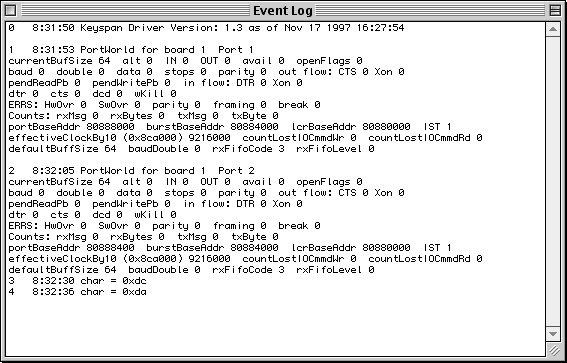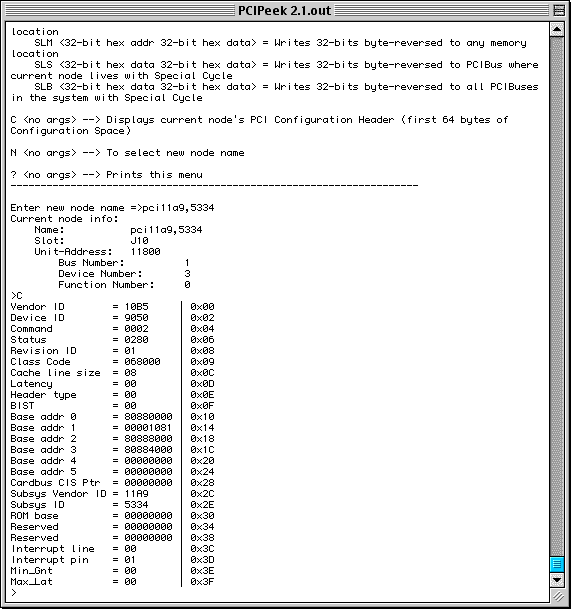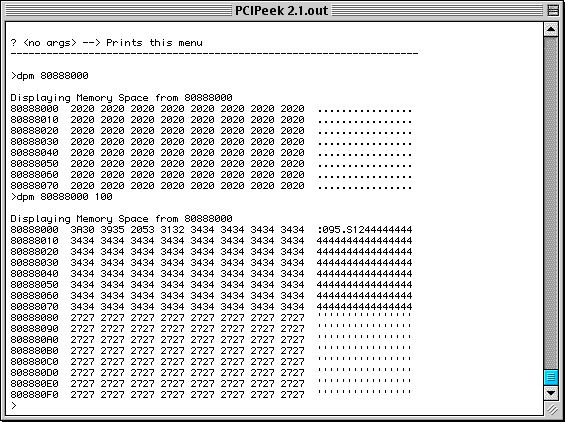This page describes
my experiences writing a LinuxPPC device driver for the Keyspan
SX serial card.
Back to Otto's
LinuxPPC Goodies page.
Gathering information
The first stage of writing the device driver consisted of gathering information
about the card I have, learning about Linux device drivers and an investigation
on existing PCI serial card drivers.
Hardware description of the card
I started by looking at the card itself. I found two big chips on it: a
chip marked PLX9050 and a chip marked ST16C654. I did searches via various
search engines on the net and came up with two links:
-
PLX Technology, a company making
PCI related devices. Here I could download the data sheet of the PLX9050
chip. This chip is a so called PCI bridge. Intended to attach slave devices
to a PCI bus.
-
Exar, a company making various mixed
signal IC's. Amongst there products is the ST16C654 four channel UART.
So it looked like the card has a fairly simple architecture: one chip containing
a UART cabable of handling four serial ports, connected to the PCI bus
via a chip that is designed to simplify access to hardware devices from
the PCI bus. Furthermore, the UART is a member of the family of UARTs commonly
found in PC's.
This information nicely corresponds with information I could find using
Linux commands. See the next sections for more details.
Why not ask Keyspan for this information?
Good question. I think it is a nice challenge to try to reverse engineer
the workings of the card. I looks like I have come a long way, without
disassembling the existing MacOS driver. Maybe I will ask Keyspan for some
confirmation on some issues at some point in time, however.
Linux kernel, device drivers and PCI information
In the meantime I studied the Linux existing serial drivers to find out
how they worked. I looked at the code in linux/drivers/char/serial.c
and linux/drivers/macintosh/macserial.c. I found out that if I
could make some glue to make the existing serial.c code talk to
the UARTs on the SX card, I had a good chance of coming up with a working
driver quickly. The serial.c code supports various UARTs from
the same family as the ST16C654 directly. Sadly, there is no PCI support
there. Other drivers, like cyclades.c do support PCI, but have
a different architecture, so a direct port is not possible.
I also read an online document about the Linux
kernel which also has a nice chapter about PCI. Sadly the "Linux Kernel
Hackers' Guide" seems to be out of date on a lot ob subjects. I also browsed
though the files in the linux/Documentation directory. The file
linux/Documentation/kernel-docs.txt
contains some references, but I found that a lot of them are outdated.
The most comprehensive source of information is the book "Linux Device
Drivers" by Alessandro Rubini. I think that understanding Linux device
drivers was not too hard for me, since I learned a lot about Unix and device
drivers in general during my study of Computer Science and subsequent jobs.
Looking at te card runing Linux
Linux > 2.1.81 has the lspci command to retrieve information about
PCI devices on the PCI bus. It is normally located in /sbin. The
following lines are an extract of the information lspci -v gives
on my machine when there is no driver available for the card:
01:03.0 Bridge: PLX Technology, Inc. PCI <-> IOBus Bridge (rev 01)
Subsystem: Unknown device 11a9:5334
Flags: medium devsel, IRQ 24
Memory at 80880000 (32-bit, non-prefetchable) [disabled]
I/O ports at 1080 [disabled]
Memory at 80888000 (32-bit, non-prefetchable) [disabled]
Memory at 80884000 (32-bit, non-prefetchable) [disabled]
The PLX9050 is located on bus 1, device 3, function 0. It is a revison
1 chip and contains subsystem vendor id 11a9 and subsystem device id 5334.
[what does medium devsel mean?] It uses interrupt request 24, and it has
three memory regions and one I/O port region, which are all disabled.
Since all memory and I/O regions are disabled, the PLX9050 is not active
in this state. It looks like the Mac Open Firmware booting process does
not enable the card, and neither does the Linux PCI startup code. See below
for configuration data from the card when running MacOS.
Existing PCI serial card drivers
First I looked on the WEB for PCI Linux serial card drivers available in
source code. After some searching I found two promising links:
-
GTEK sells a card that very much looks
like the SX card: the JetPort
II. Look at the picture and you can see the nice big PLX logo. When
I found this information I thought I was very lucky: a card that use the
PLX9050 and the ST16C654 and with an available Linux
driver! Alas, it did not work:
- [add info about the JetPort driver and why it didn't work]
-
Connect Tech Inc. has a Linux
driver for their BlueHeat
card. It can be found here.
- [add info about the BlueHeat driver and why it didn't work]
Investigating the card running MacOS
Next thing I tried was getting as much information about the card as possible.
When running MacOS, that card is enabled, so I thought it was a good idea
to look at the card when it is operating.
SX Manager
SX Manager is a little program that comes with the SX card MacOS driver.
It has a reporting facility. Here is a screen shot of the SX Manager Event
Log after asking for port statistics for both ports:

We can see some interesting things in this window:
-
First, the addresses we saw using the lspci command come back
here. So MacOS is using the same PCI address configuration as Linux.
-
The only address that differs between the two ports is the
portBaseAddr.
The name of the address suggest that the UARTs are mapped to these locations
by the PLX9050. At this point in time, I don't know what burstBaseAddr
is used for. lcrBaseAddr is the base address of the "Local Configuration
Register" of the PLX9050. Note that there is no mentioning of any I/O address
in this screen shot
-
Item 3 and 4 are just reports of me typing the wrong key combination for
screen shots on the Mac...
PCIPeek
PCIPeek is a program that comes with the PCI developers' kit available
free from Apple. Here are two screen shot of PCIPeek:

This screen shows the local configuration registers from the PLX9050.
The most interesting one is probably the command register, which shows
that only memory access is enabled. I/O access is disabled. This information
confirms the suspicion that the UARTs are accessed memory mapped, and not
I/O mapped. This has big consequences since most UART drivers I have seen
use I/O mapping. This explains why the drivers I tried could not contact
the UART!

But of course Keyspan had some extra surpise. This one took me some
time to find out: the UART registers are not mapped to a memory region
of 7 consequtive bytes, but are mapped 0x80 bytes apart from each
other. Reading from offset 0x00 to 0x7f just reads the
same register! You can see data coming out of the UART in the bottom half
of the screen dump nicely. The second block shows the value of the interrupt
status register. The reason the first block of data changes in the middle
is that while I was executing the dpm command, my modem was dumping
its configuration at 300 baud to a terminal window. I happened to catch
a part of one of the S register settings.
The first working probe!
Here you can
find the code of the very first working version of a device driver that
does a probe for the SX card and its UARTs. This code works if you have
a 2.2.10 source tree with
this
patch applied first. With other kernel versions it may also work, but
I did not test that.
[add some explanation here]
Design decisions to make
There are some design issues to resolve before I can proceed writing the
real driver. I requested some assistence by sending out a mail to various
mailing lsists. You can find the request here.
If You have any comment to make, I'd like to hear.
Testing
Currently I am organizing some people to test the driver. The first step
was set on Monday, Aug 9 1999. I send out a call to the linuxppc-dev
and linuxppc-user mailing lists and the comp.os.linux.powerpc
newsgroup. You can find the call here.
The Future
Originally, the following items were on my wish list:
-
support for any PLX9050 based serial card with any of the serial.c
UARTs?
-
What about other bridge chips?
-
More platforms!
Well, it looks like the future is here! The Keyspan SX driver evolved into
a general purpose PCI serial driver. If you have a "dumb" PCI serial card
and are running Linux 2.2.x on Intel, PowerPC, Alpha or any other system
supporting PCI, chances are the driver will work for you. More information
can be found here.
Please email comments to Otto
Moerbeek


![]()
